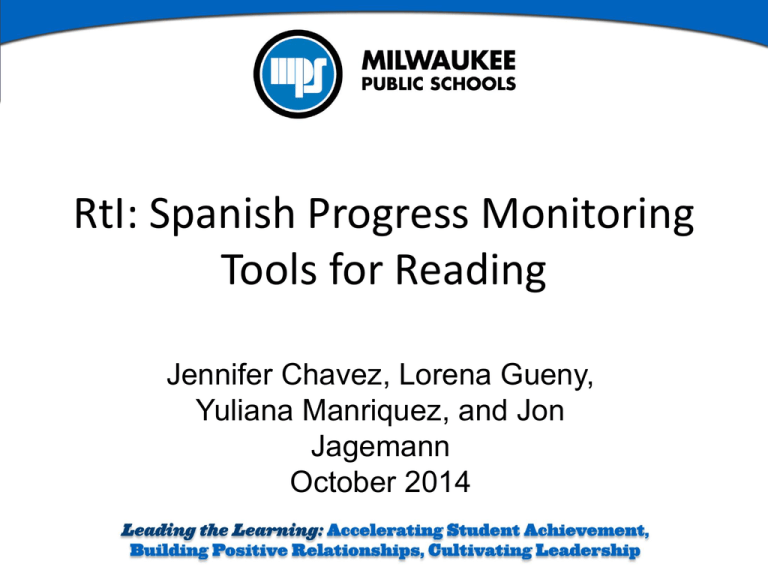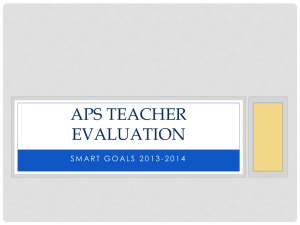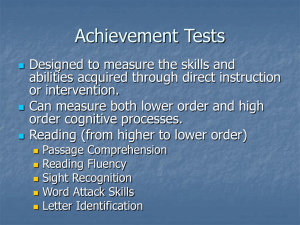Progress Monitoring Tool - Milwaukee Public Schools
advertisement

RtI: Spanish Progress Monitoring Tools for Reading Jennifer Chavez, Lorena Gueny, Yuliana Manriquez, and Jon Jagemann October 2014 Learning Intention • How to administer, collect progress monitoring data, and locate Spanish progress monitoring tools in order to present this information to bilingual staff members at your school. Success Criteria • Review the logistics of how to use Spanish progress monitoring tools • Identify where Spanish progress monitoring resources are located • Begin to create an action plan for how Spanish progress monitoring tools will be presented to the bilingual staff members at your school Teaching the CHILD • http://www.youtube.com/watch?v=1wuSaNCI de4 RtI Process a process for achieving higher levels of academic and behavioral success for all students Why Progress Monitor? We CAN change outcomes for students. Progress monitoring is one part of a system. Progress monitoring serves as an indicator. Focus is to teach the Basic Early Literacy Skills explicitly and thoroughly. Monitor progress frequently and efficiently. Basic Early Literacy Skills Phonics • Phonemic Awareness • Phonics • Fluency • Vocabulary • Comprehension Phonemic Awarenes s Focus on specific literacy skills can improve a child’s ability to read. Fluency Vocabulary Comprehension Spanish Interventions for Students in the Bilingual Program • If a student is an English Language Learner (ELL), formal academic interventions are to be used to assess a student’s academic progress. • Should be based on a student’s academic deficiency, not lack of second language development • Teachers and school teams should use the ELL Language of Academic Intervention Considerations* (handout) when considering what language would be of academic intervention. *adapted from Culturally and Linguistically Responsive RtI2 Planning Form – WIDA Consortium Please Keep in Mind: • The purpose of this presentation is to share the progress monitoring tools that are to be used with students in a bilingual program that have been identified for tier 2/3 interventions. • Students identified for tier 2/3 interventions should be progress monitored at instructional level. • This presentation will not be referring to specifics relating to the SLD referral process. Please Keep in Mind: • K4 - 2nd grades should use PALS Español and/or easyCBM Spanish Literacy Benchmark results in the screening process of aid in identifying students for interventions. • These results can also help guide teachers in determining which basic early literacy skill students need support • Other formative and summative data should be used taken into consideration such as Spanish Tesoros Verifications, unit/weekly assessments, etc. Please Keep in Mind: • The following progress monitoring tools come in two forms: – Spanish Reading Progress Monitoring Packets – easyCBM Probes • References/content of Spanish Reading Progress Monitoring Packets – Combination of Tesoros, IDEL, and DIBELS resources Teachers should refrain from using the A Nivel Cuaderno de Práctica fluency passages as classwork/homework/etc. since they are used as progress monitoring tools now Letter Sounds - Overview Area of Concern Basic Early Literacy Skill Letter Sounds Phonics Instructional Levels Available K Progress Monitoring Tool Spanish Progress Monitoring: Letter Sounds EXCEED Template Name Spanish Letter Sounds Frequency of Progress Monitoring After every 5 intervention sessions Letter Sounds - Directions Timing 1 minute Score Student receives 1 point for each correct letter sound in a minute. Scoring Rules •Leave blank any letter sound a student said correctly. The lower case “L” may look like an upper case “I”. Give student point for either saying the sound of an “L” or “I”. •Put a slash (/) over any incorrect letter sound. •Inserted sounds and repeated sounds are ignored and not counted as errors. •A sound is scored as incorrect if it is initially misread, but if the student self-corrects within 3 seconds, mark SC above the letter and score as correct. •If a student skips a row cross out the entire row and count the omitted sounds as errors. Wait Rule No response within 3 seconds, say the sound & cue them to say the next sound Discontinue Rule Zero correct sounds in the first five letters Letter Sounds - Scoring and Baseline Calculating Final Score Determining Baseline Add total sounds read correctly within the minute and record it next to Total Correct. Before implementing any intervention, student’s baseline must be calculated •Administer (3) Letter Sounds Progress Monitoring lists. •Determine Total Sounds Correct for each list. •Choose the Total Sounds Correct MEDIAN (middle) score for the baseline. For example, if a student scored a 10, 13, 11. Put in order from least to greatest and choose the middle score: Baseline would be 11. Letter Sounds – samples Letter Sounds – scoring example 23 S.C. S.C ] Phoneme Segmentation Fluency - Overview Area of Concern Basic Early Literacy Skill Phoneme Segmentation Fluency (identifying sounds in a word) Phonemic Awareness Instructional Levels Available K-1 grade Progress Monitoring Tool easyCBM Probes – Spanish: Syllable Segmenting EXCEED Template Name Spanish Phonemic Segmentation Fluency Frequency of Progress Monitoring After every 10 intervention sessions Phoneme Segmentation Fluency Directions Timing 1 minute Score Student receives 1 point for each syllable said correctly in a minute. Scoring Rules • Underline each syllable the student says correctly • Put a slash through each syllable the student misses. • Students are not penalized for saying extra words. Wait Rule No response within 3 seconds, say the word in syllables and student continues to next word Discontinue Rule Zero correct sound segments in the first five words Phoneme Segmentation Fluency – - Scoring and Baseline Calculating Final Score Determining Baseline Add total syllables said correctly within the minute and record it next to # Correct. Before implementing any intervention, student’s baseline must be calculated Find percentile of probe score: • Path 1: above the 50th percentile, doesn’t support need for intervention in that area • Path 2: between the 10th and 50th percentile, use the probe percentile score as baseline • Path 3: below the 10th percentile, use lower level probe making adjustments until the student is scoring between the 10th and 50th percentile, use the probe percentile score as baseline. Phoneme Segmentation Fluency – Sample Phoneme Segmentation Fluency – Scoring Example 2 2 2 2 2 2 1 2 1 1 17 Basic Phonics - Overview Area of Concern Basic Early Literacy Skill Basic Phonics Skills (vowels and syllables) Phonics Instructional Levels Available K-1 grade Progress Monitoring Tool easyCBM Probes- Spanish: Syllable Sounds EXCEED Template Name Spanish Phonemic Basic Phonics Frequency of Progress Monitoring After every 10 intervention sessions Basic Phonics - Directions Timing 1 minute Score Student receives 1 point for each correct syllable sound in a minute. • • Scoring Rules • • • • Wait Rule Discontinue Rule Self corrects, write S.C. above syllable and count as correct. Says incorrect syllable, slash through syllable, write the response above and count as incorrect. Skips syllable, circle the syllable and count as incorrect Clearly loses his/her place, point to the next syllable. Says one of the multiple correct syllable sounds, count as correct. Example: for the syllable ra, either /ra/ or /rra/ is acceptable. Place a bracket (]) after the last word read. No response within 3 seconds, say the syllable and count as incorrect. Zero correct sound syllables out of the first five Basic Phonics – Scoring and Baseline Calculating Final Score Determining Baseline Add total syllables read correctly within the minute and record it next to # Correct. Before implementing any intervention, student’s baseline must be calculated Find percentile of probe score: • Path 1: above the 50th percentile, doesn’t support need for intervention in that area • Path 2: between the 10th and 50th percentile, use the probe percentile score as baseline • Path 3: below the 10th percentile, use lower level probe making adjustments until the student is scoring between the 10th and 50th percentile, use the probe percentile score as baseline. Basic Phonics – Sample Basic Phonics – Scoring Example ti S.C. S.C ] 35 Reading Words - Overview Area of Concern Basic Early Literacy Skill Reading Words (applying phonics skills to decode) Phonics Instructional Levels Available 1-2 grades Progress Monitoring Tool easyCBM Probes – Spanish: Word Reading EXCEED Template Name Spanish Real Word Reading Frequency of Progress Monitoring After every 10 intervention sessions Reading Words - Directions Timing 1 minute Score Student receives 1 point for each correct word read in a minute. • Scoring Rules • • Wait Rule Discontinue Rule If a student self corrects, write S.C. above the word and count it as correct. If they say an incorrect word, mark a slash through the word and count it as incorrect. If the students skips a word, circle the word and count it as incorrect. No response within 3 seconds, say the word (mark as incorrect) & cue them to say the next word. Zero correct sound segments in the first five words Reading WordsScoring and Baseline Calculating Final Score Determining Baseline Add total words read correctly within the minute and record it next to # Correct. Before implementing any intervention, student’s baseline must be calculated Find percentile of probe score: • Path 1: above the 50th percentile, doesn’t support need for intervention in that area • Path 2: between the 10th and 50th percentile, use the probe percentile score as baseline • Path 3: below the 10th percentile, use lower level probe making adjustments until the student is scoring between the 10th and 50th percentile, use the probe percentile score as baseline. Reading Words - Example Reading Words – Scoring Sample S.C. ] 19 Sentence Fluency Rate – Overview Area of Concern Basic Early Literacy Skill Sentence Fluency Rate Fluency Instructional Levels Available 1-2 grades Progress Monitoring Tool easyCBM Probes– Spanish: Sentence Reading EXCEED Template Name Spanish Sentence Fluency Rate Frequency of Progress Monitoring After every 10 intervention sessions Sentence Fluency Rate – Directions Timing 1 minute Score Student receives 1 point for each correct word read in a minute. • • Scoring Rules • • Wait Rule Discontinue Rule If a student self corrects, write S.C. above the word and count it as correct. If they say an incorrect word, mark a slash through the word and count it as incorrect. If the students skips a word, circle the word and count it as incorrect. Place a bracket (]) after the last word read. No response within 3 seconds, say the next word Zero correct sound segments in the first five words Sentence Fluency Rate – Scoring and Baseline Calculating Final Score Determining Baseline Add total sounds read correctly within the minute and record it next to Total Correct. Before implementing any intervention, student’s baseline must be calculated Find percentile of probe score: • Path 1: above the 50th percentile, doesn’t support need for intervention in that area • Path 2: between the 10th and 50th percentile, use the probe percentile score as baseline • Path 3: below the 10th percentile, use lower level probe making adjustments until the student is scoring between the 10th and 50th percentile, use the probe percentile score as baseline. Sentence Fluency Rate – Sample Sentence Fluency Rate – Scoring Example S.C. S.C. ] 28 2 26 Passage Fluency Rate – Overview Area of Concern Basic Early Literacy Skill Passage Fluency Rate Fluency Instructional Levels Available 3-6 grades Progress Monitoring Tool Spanish Progress Monitoring: Leveled Fluency EXCEED Template Name Spanish Passage Fluency Rate Frequency of Progress Monitoring After every 5 intervention sessions Passage Fluency Rate – Directions Timing 1 minute Score Student receives 1 point for each correct word read in a minute. Scoring Rules Wait Rule Discontinue Rule •To be counted as a correctly read word, the whole word must be read, not just sounds. •Inserted words, repeated words, and phrases are ignored and not counted as errors. •A word is scored as incorrect if it is initially misread, but if the student self-corrects within 3 seconds, mark SC above the word and score as correct. •Proper nouns read with correct pronunciation or with any reasonable phonetic pronunciation are counted as correct. •Put a slash (/) through any errors. Errors include: -Words read incorrectly -Substitutions -Omitted words -Hesitations more than 3 seconds -Words read out of order -Words that are sounded out, but not read as a whole word •If the students skips a word, circle the word and count it as incorrect. •If a student skips a row cross out the entire row and count the omitted words as errors. If no response in 3 seconds, say the word and mark it as incorrect. If necessary, indicate for the student to continue reading. If no words are read correctly in the first line, say PARA, record a score of “0.” If student earns a score of “0,” then progress monitor at the next instructional level below. Passage Fluency Rate – Scoring and Baseline Calculating Final Score Determining Baseline Add total sounds read correctly within the minute and record it next to Total Correct. Before implementing any intervention, student’s baseline must be calculated •Administer (3) Letter Sounds Progress Monitoring lists. •Determine Total Sounds Correct for each list. •Choose the Total Sounds Correct MEDIAN (middle) score for the baseline. For example, if a student scored a 10, 13, 11. Put in order from least to greatest and choose the middle score: Baseline would be 11. Passage Fluency Rate – Sample Passage Fluency Rate – Scoring Example 42 3 39 S.C. S.C. ] Comprehension – Overview Area of Concern Basic Early Literacy Skill Reading Comprehension Comprehension Instructional Levels Available 2-6 grades Progress Monitoring Tool Spanish Progress Monitoring: Leveled Comprehension EXCEED Template Name Spanish Monitoring Comprehension Frequency of Progress Monitoring After every 5 intervention sessions Comprehension – Directions Retelling Guidelines Score Scoring Rules Students may read passage to self or aloud. Reading strategies of referring back to the text and repeated readings may be practiced and encouraged during reading intervention instruction. In order to monitor the effectiveness of these strategies in enhancing student comprehension, student should read the passage once and while retelling, student should not have the passage in front of them for general or explicit reference. Use rubric found below the comprehension passage to determine final score. Quality of Response: (Note: If the student provides only a main idea, it is considered one detail) 0 Cannot provide any details about the story. 1 Provides 2 or fewer details. 2 Provides 3 or more details. 3 Provides 3 or more details in a meaningful sequence. 4 Provides 3 or more details in a meaningful sequence that captures the main idea. Wait/Reminder If a student has not said anything at all, provides a very limited response, or provides an off-track response, ask ¿Puedes decirme algo sobre lo que leíste? or ¿Me puedes dar más detalles o información importante sobre lo que acabas de leer? Discontinue Rule After the reminder, if the student does not say anything, say “Gracias” and discontinue the task. If student gets off-track, repeat the directions. Comprehension – Scoring and Baseline Calculating Final Score Determining Baseline Use rubric found below the comprehension passage to determine final score. Before implementing any intervention, student’s baseline must be calculated •Administer (3) Comprehension Progress Monitoring Passages. •Determine the rubric score for each passage. •Find the MEDIAN (middle) score for the baseline. For example, if a student scored a 1, 2, 1. Put in order from least to greatest and choose the middle score: Baseline would be 1. Comprehension – Sample Comprehension – Scoring Example Example: -Se trata de niños que juegan y hombres que están preparando una canoa. Las mujeres cocinan también. “It is about children who are playing and men who are preparing a canoe. The women cook, too.” (Student gives three details, but not in a meaningful sequence) Grades 7th – 8th • These progress monitoring tools are to be used for students that are in 7th or 8th grade and have been identified for Spanish Reading intervention. Additional Resources - handouts • Bilingual Reading RtI Instructional Resources – An overview of the multi-level tiers of support in Spanish Reading • Bilingual (Spanish) Literacy RtI Alignment – Aligns area of concern, progress monitoring tool, instructional levels available, EXCEED templates and frequency of progress monitoring. • Bilingual (Spanish) Literacy Baseline/Goal Guide – Provides a quick guide to baseline setting and goal setting for all the progress monitoring tools. Also provides passage fluency rates. • easyCBM Percentile Table – Concise list of easyCBM Spanish literacy progress monitoring scores converted into percentiles • Bilingual Literacy Intervention EXCEED BASICS – Direction in how to create an EXCEED plan using bilingual (Spanish) EXCEED template Locating Progress Monitoring Resources ① Go to the MPS Homepage ② Click on Families ③ Click on RtI & PBIS Locating Progress Monitoring Resources Cont. ① On the right side of the RtI & PBIS homepage, click on Resources Locating Progress Monitoring Resources Cont. Scroll down to Spanish Bilingual Resources Click here for documents directly related to Progress monitoring Resources Click here to find all Spanish Progress Monitoring Tools Locating Progress Monitoring Resources Cont. Locating Progress Monitoring Resources Cont. Scroll down to Literacy Resources Click here for documents directly related to easyCBM For any EXCEED resources SLD Process •If a student is moving toward a process of a SLD determination, intervention progress monitoring must occur at grade-level and weekly. •For more information on the SLD determination process as it relates to a RtI, contact your school psychologist. Next Steps – Action Planning • Guiding Questions – How and when will this information be shared with all bilingual staff members? – How and when will bilingual teachers be offered Spanish progress monitoring resource support after information is initially shared? Any additional questions about these progress monitoring tools? Please contact your RtI/PBIS Coach RtI: Spanish Progress Monitoring Tools for Reading MPS Board of School Directors Senior Team Michael Bonds, Ph.D., President, District 3 Meagan Holman, Vice President, District 8 Mark Sain, District 1 Jeff Spence, District 2 Annie Woodward, District 4 Larry Miller, District 5 Tatiana Joseph, Ph.D., District 6 Claire Zautke, District 7 Terrence Falk, At-Large Darienne B. Driver, Ed.D., Superintendent Erbert Johnson, CPA, Chief of Staff Tina Flood, Chief Academic Officer Karen Jackson, Ph.D., Chief Human Capital Officer Ruth Maegli, Acting Chief Innovation Officer Michelle Nate, Chief Operations Officer Gerald Pace, Esq., Chief Financial Officer Keith Posley, Ed.D., Chief School Administration Officer Sue Saller, Executive Coordinator, Superintendent’s Initiatives








